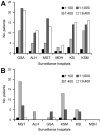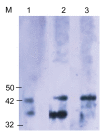High seroprevalence of antibodies against spotted fever and scrub typhus bacteria in patients with febrile Illness, Kenya
- PMID: 25811219
- PMCID: PMC4378494
- DOI: 10.3201/eid2104.141387
High seroprevalence of antibodies against spotted fever and scrub typhus bacteria in patients with febrile Illness, Kenya
Abstract
Serum samples from patients in Kenya with febrile illnesses were screened for antibodies against bacteria that cause spotted fever, typhus, and scrub typhus. Seroprevalence was 10% for spotted fever group, <1% for typhus group, and 5% for scrub typhus group. Results should help clinicians expand their list of differential diagnoses for undifferentiated fevers.
Keywords: Kenya; Rickettsia; bacteria; rickettsial infections; scrub typhus; seroprevalence; spotted fever; typhus fever.
Figures


References
-
- Jiang J, Marienau KJ, May LA, Beecham HJ 3rd, Wilkinson R, Ching WM, et al. Laboratory diagnosis of two scrub typhus outbreaks at Camp Fuji, Japan in 2000 and 2001 by enzyme-linked immunosorbent assay, rapid flow assay, and Western blot assay using outer membrane 56-kD recombinant protiens. Am J Trop Med Hyg. 2003;69:60–6. - PubMed
Publication types
MeSH terms
Substances
LinkOut - more resources
Full Text Sources
Other Literature Sources

